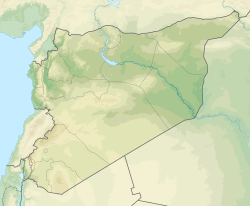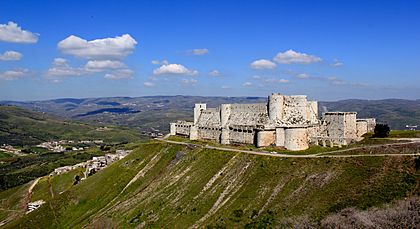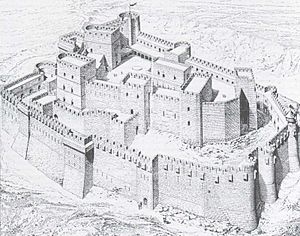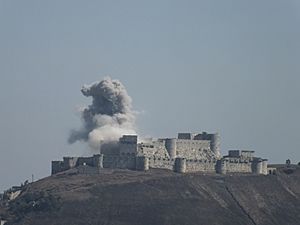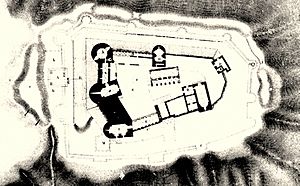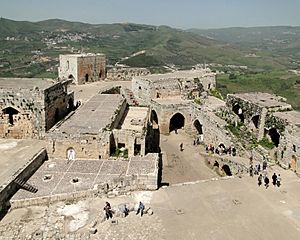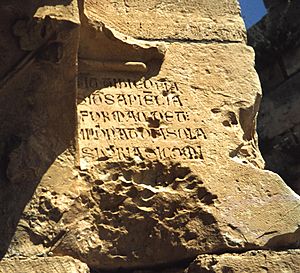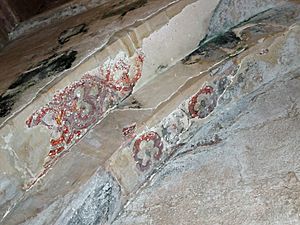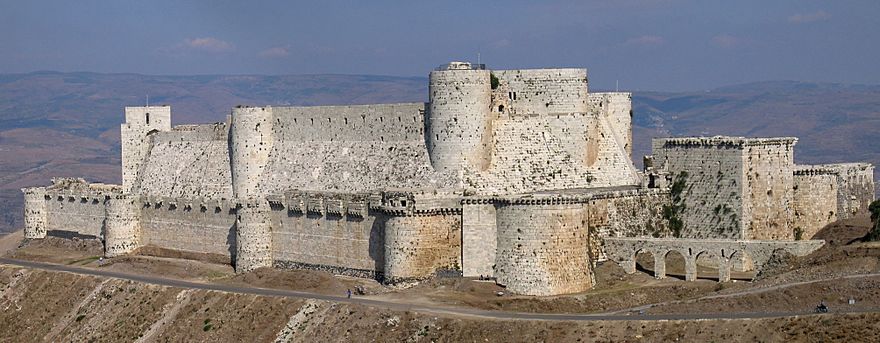Krak des Chevaliers facts for kids
Quick facts for kids Krak des Chevaliers |
|
|---|---|
| قلعة الحصن | |
| by Al-Husn, Talkalakh District, Syria | |
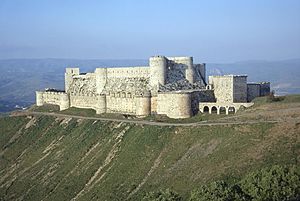
Krak des Chevaliers from the southwest
|
|
| Coordinates | 34°45′25″N 36°17′41″E / 34.7570°N 36.2947°E |
| Type | Concentric castle |
| Site information | |
| Controlled by |
|
| Open to the public |
Accessible |
| Condition | Mostly good but damaged due to Syrian Civil War |
| Site history | |
| Built |
|
| Built by |
|
| Materials | Limestone |
| Battles/wars | |
The Krak des Chevaliers (pronounced Krak deh She-val-yay) is a famous medieval castle in Syria. It is also known as Hisn al-Akrad, which means "Fortress of the Kurds". Many people consider it one of the most important and well-preserved medieval castles in the world.
The first castle on this spot was built in the 11th century by Kurdish troops. Later, in 1142, a group of warrior monks called the Knights Hospitaller took control of it. They rebuilt and expanded the castle, making it much stronger. The Hospitallers held the castle until 1271, when it was captured by the Mamluk Sultan Baibars.
The Knights Hospitaller finished their main rebuilding work by 1170. An earthquake damaged the castle that year, but they repaired it. Krak des Chevaliers became a very important base for the Hospitallers. It served as a center for their operations and a military stronghold. In the 13th century, more building work made it a concentric castle, meaning it had strong outer and inner walls.
At its peak, Krak des Chevaliers could hold about 2,000 soldiers. This large army helped the Hospitallers collect payments from the surrounding areas. However, things changed in the 1250s. In 1271, Sultan Baibars captured the castle after a 36-day siege. It is said he used a fake letter to trick the Knights into surrendering.
In the 19th century, people became interested in Crusader castles again. Plans of Krak des Chevaliers were drawn up. For a while, a village grew inside the castle, causing some damage. In 1933, the villagers moved out, and the castle was restored. Today, the village of al-Husn is located around the castle.
Krak des Chevaliers is about 40 kilometers (25 miles) west of the city of Homs. Since 2006, it has been a World Heritage Site recognized by UNESCO. The castle was partly damaged during the Syrian Civil War but was recaptured by the Syrian government in 2014. Since then, efforts to repair and preserve this amazing historical site have begun.
Contents
What's in a Name?
The modern Arabic word for a castle is qalʿa. However, Krak des Chevaliers is known as a "ḥiṣn", which means "fort". This name comes from an older fort on the same spot called Ḥoṣn al-Akrād, or "fort of the Kurds".
The Crusaders, who were often called "Franks", named it Le Crat. Later, this name got mixed up with the word karak, which also means "fortress". So, it became Le Crac. Crat was probably the French way of saying Akrād, the Arabic word for Kurds.
After the Knights Hospitaller took over, the castle was called Crac de l'Ospital. Later, it became known as Crac des Chevaliers, where Chevalier is the French word for "Knight". This is why it's called the "Fortress of the Knights".
Where is Krak des Chevaliers Located?
This impressive castle sits on top of a 650-meter (2,130-foot) high hill. It is located east of Tartus in Syria, in an important area called the Homs Gap. This gap is a strategic route that connects the cities of Tripoli and Homs.
To the north of the castle are the Jebel Ansariyah mountains. To the south is Lebanon. The land around the castle is very fertile, with many streams and good rainfall. This area was important for farming.
The Knights Hospitaller received this land in the 1140s. It included Krak des Chevaliers and other towns. Homs was never under Crusader control, so the area around the castle was sometimes attacked from there. However, the castle's location also allowed the Knights to launch their own raids. Because it overlooked the plain, Krak des Chevaliers became the most important base for the Knights in this region.
History of the Castle

Early Days and Crusader Control
In 1031, an emir (ruler) named Shibl al-Dawla Nasr built a fort here. He settled Kurdish tribesmen at the site, which was then called Ḥiṣn al-Safḥ. This was done to help his family, the Mirdasids, reach the coast of Tripoli. Because of the Kurdish troops, the fort became known as Ḥiṣn al-Akrād (Fortress of the Kurds). It was perfectly placed to control the road between Homs and Tripoli.
In 1099, during the First Crusade, Crusader armies passed by the fort. They briefly occupied it but then left to continue their journey to Jerusalem. The Crusaders permanently took control in 1110. The first castle was very different from what we see today; no parts of it remain.
The Knights Hospitaller started as a religious group in Jerusalem around the 1070s. They cared for the sick and helped pilgrims visiting the Holy Land. After the Crusaders captured Jerusalem in 1099, many Crusaders gave land to the Hospital of St John. By the 1130s, the order became more military, protecting pilgrims and their lands.
Between 1142 and 1144, Raymond II, the Count of Tripoli, gave Krak des Chevaliers and other castles to the Hospitallers. This made the Hospitallers very powerful in the region. They agreed to defend Tripoli. The Hospitallers made Krak des Chevaliers their main administrative center. They began building a new, stronger castle to replace the old fort.
This building work lasted until 1170. An earthquake damaged the castle, including its chapel. The chapel was later rebuilt. In 1163, the Crusaders won a battle against Nur ad-Din near Krak des Chevaliers.
Between 1175 and 1180, a drought led to a truce between Crusaders and Muslims. However, raids continued. In 1180, Saladin attacked the County of Tripoli. The Crusaders hid in their strong castles. Saladin could not capture the castles, so he retreated.
The Battle of Hattin in 1187 was a huge defeat for the Crusaders. Many important figures were captured, and Saladin ordered the execution of captured Templar and Hospitaller knights. After this, the Hospitallers focused on defending their castles in Tripoli. In 1188, Saladin tried to attack Krak des Chevaliers, but he saw it was too strong and moved on.
Another earthquake hit in 1202. After this, the castle was rebuilt again. This 13th-century work gave Krak des Chevaliers its current look. New outer walls were added, making it a true concentric castle.
The first half of the 13th century was the "golden age" for Krak des Chevaliers. While other Crusader castles were in danger, Krak des Chevaliers and its 2,000 soldiers controlled the area. It was the only major inland area that stayed under Crusader control for a long time. Many Crusaders visited the castle and gave donations. King Andrew II of Hungary visited in 1218 and called it the "key of the Christian lands".
Krak des Chevaliers was also used as a base for attacks on nearby Muslim territories. By 1203, the garrison was raiding areas like Montferrand and Hama. In 1207 and 1208, the castle's soldiers attacked Homs.
The Castle's Decline and Capture
In the 1250s, things started to go badly for the Hospitallers at Krak des Chevaliers. A large Muslim army attacked the countryside around the castle in 1252. The Order's money problems grew. By 1268, the Grand Master, Hugues Revel, reported that the area was deserted. He also said there were only 300 Hospitaller knights left in the East.
In 1260, Baibars became the Sultan of Egypt. He united Egypt and Syria. This meant that Muslim towns that used to pay tribute to Krak des Chevaliers no longer felt forced to do so.
Baibars came to the area around Krak des Chevaliers in 1270. He then left to avoid a fight with King Louis IX of France. After Louis died in 1271, Baibars returned to deal with Krak des Chevaliers. Before attacking the main castle, he captured smaller castles nearby.
On March 3, Baibars' army arrived at Krak des Chevaliers. Peasants from the area had fled to the castle for safety. Baibars set up large mangonels (siege weapons). After two days, the first line of defenses fell.
Rain stopped the siege for a bit. But on March 21, Baibars' forces captured a triangular outer defense. On March 29, the attackers dug under a tower in the southwest corner, causing it to collapse. Baibars' army then attacked through the opening. They entered the outer ward, where the peasants were. The Crusaders retreated to the stronger inner ward.
After ten days, the attackers sent a letter to the garrison. It seemed to be from the Grand Master of the Knights Hospitaller, giving them permission to surrender. Even though the letter was fake, the Knights gave up on April 8, 1271. Sultan Baibars spared their lives. The new owners repaired the castle, especially the outer ward. The Hospitaller chapel was turned into a mosque.
Later History and Modern Times
During the Ottoman period (1516–1918), the castle housed local soldiers. It was the center of a tax district. Later, in the 18th century, local families controlled the area. By 1894, the Ottoman government thought the castle was too old and hard to reach for military use.
After the Crusaders left the Holy Land in 1291, people in Europe forgot about these castles. It wasn't until the 19th century that interest grew again. Emmanuel Guillaume-Rey was the first European to study Crusader castles scientifically in 1871. He published plans and drawings of Krak des Chevaliers.
In 1927, Paul Deschamps visited the castle. A village of 500 people had grown inside it, causing damage. Deschamps worked to clear and restore the site. In 1933, Krak des Chevaliers was given to the French state. The villagers were moved and compensated. Over the next two years, 120 workers cleaned and restored the castle. It became a major tourist attraction.
When Syria became independent in 1946, it took control of the castle. In 2006, UNESCO declared Krak des Chevaliers a World Heritage Site.
Today, the village of al-Husn is home to about 9,000 people. Many residents benefit from tourism to the castle.
The Syrian Civil War started in 2011. UNESCO worried about damage to cultural sites like Krak des Chevaliers. The castle was damaged by shelling in August 2012 and again in July and August 2013. The Syrian army captured the castle and al-Hosn village in March 2014. Since then, UNESCO and the Syrian government have been working on its reconstruction and preservation.
Castle Design and Features
The famous writer T. E. Lawrence (Lawrence of Arabia) called Krak des Chevaliers "perhaps the best preserved and most wholly admirable castle in the world." Castles in the Levant (the Middle East) were built mainly for defense. Krak des Chevaliers is a great example of a castle designed as a "fighting machine."
Krak des Chevaliers is a spur castle because of its location on a hill. After its expansion in the 13th century, it became a full concentric castle. This means it has strong inner and outer walls. The castle was built mainly from limestone. The stones fit so well that you can barely see the mortar.
Inner Walls and Courtyard
Between 1142 and 1170, the Knights Hospitaller built the first strong stone walls. These walls had square towers. The main entrance was on the eastern side. Inside, there was a central courtyard surrounded by vaulted rooms. The castle's irregular shape was due to the natural shape of the hill.
When the castle was rebuilt in the 13th century, new walls were added around the inner court. These new walls followed the older ones, leaving a narrow space between them. This space became a gallery where defenders could shoot missiles. The walls were supported by a steeply sloped base called a glacis. This helped protect against siege weapons and earthquakes.
Four large, round towers stick out from the glacis. These towers were living quarters for the Knights, who numbered about 60 at the castle's busiest time. The southwest tower was for the Grand Master of the Knights Hospitaller. The area between the inner and outer walls was narrow and not used for living. On the east side, where defenses were weaker, there was an open cistern (water tank). It acted as both a moat and a water supply.
At the north end of the small courtyard is a chapel. At the south end is a raised open area called an esplanade. The vaulted space beneath the esplanade was used for storage or as shelter. Along the west side of the courtyard is the Hall of the Knights. Its beautiful Gothic architecture dates from the 13th century.
The Chapel
The current chapel was likely built after the original one was destroyed by the 1170 earthquake. Only a small part of the first chapel remains. The new chapel had a simple design with a barrel vault. It was about 21.5 meters (70 feet) long and 8.5 meters (28 feet) wide. It had a main entrance from the west and a smaller one on the north. When the castle was remodeled in the early 13th century, the main entrance was moved to the south wall. The chapel was lit by windows above the walls.
Outer Walls and Entrance
The second major building phase by the Hospitallers began in the early 13th century. This is when the outer walls were built, giving Krak des Chevaliers its current look. These outer walls were 9 meters (30 feet) high and had strong, rounded towers. This rounded tower design was new for its time.
The walls and towers had arrow slits, allowing defenders to shoot arrows. Machicolations (openings in the floor of projecting parts of the wall) allowed defenders to drop things on enemies below. These defenses were very advanced. Historian Hugh Kennedy called the outer wall defenses "the most elaborate and developed anywhere in the Latin east."
When the outer walls were built, the main entrance was also made stronger. A long, vaulted corridor led uphill from the outer gate. This corridor had a sharp turn halfway, making it a "bent entrance." Bent entrances were a clever way to slow down attackers. This one was about 137 meters (450 feet) long. Along the corridor were "murder-holes" where defenders could drop missiles on attackers. To reach the inner castle, attackers had to follow this winding passage.
Castle Art: Frescoes
Even though it was a military fortress, Krak des Chevaliers has some rare examples of Crusader art in the form of frescoes (wall paintings). These medieval frescoes were found in the main chapel and another chapel outside the main entrance. They were discovered after later plaster and paint wore away.
The frescoes inside the chapel were painted after the 1170 earthquake. They are in red and blue colors. Because of mold, smoke, and moisture, they are hard to see clearly. One fresco on the outside of the chapel showed the Presentation of Jesus at the Temple. These paintings give us a glimpse into the art of the Crusader period.
Images for kids
-
The Levant in 1135, with Crusader states marked by a red cross.
-
The east end of the castle's barrel-vaulted chapel.
See Also
 In Spanish: Crac de los Caballeros para niños
In Spanish: Crac de los Caballeros para niños
- List of castles in Syria
- List of Crusader castles
- World Heritage Sites in Danger


